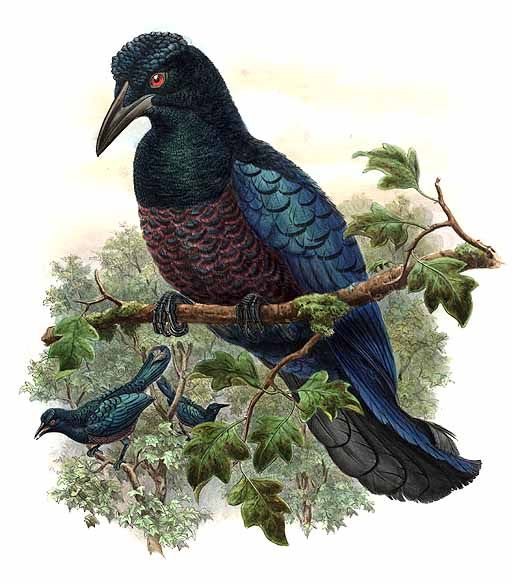|
| Query: bird | Result: 4653rd of 32675 | |
Curl-crested Manucode (Manucodia comrii) - Wiki
| Subject: | Curl-crested Manucode (Manucodia comrii) - Wiki
| |

| Resolution: 513x583
File Size: 52915 Bytes
Upload Date: 2013:01:16 15:39:54
|
[Photo] Curl-crested Manucode (Manucodia comrii). Author: Richard Bowdler Sharpe. Source: http://www.oiseaux.net/photos/bowdler.sharpe/ http://en.wikipedia.org/wiki/Curl-crested_Manucode License: public domain
The Curl-crested Manucode (Manucodia comrii) is a compact and large, approximately 43 cm long, bird-of-paradise with glossy purple, black and green plumage, red iris and crinkled yellowish-green upper breast and neck feathers. It has curled head feathering and twisted central tail feathers. Both sexes are similar with a slightly smaller female. It is the largest species of Manucode, and also the largest species in its family in terms of body size,[2] though its tail is shorter than the Black Sicklebill.
Endemic to Papua New Guinea, the Curl-crested Manucode is distributed to the Trobriand Islands and islands of the D'Entrecasteaux Archipelago. This species is also one of the largest and heaviest among birds of paradise. The diet consists mainly of fruits.
The British zoologist Philip Lutley Sclater named this species after Dr. Peter Comrie, who discovered the bird at Fergusson Island in 1874.
A common species in its limited habitat range, the Curl-crested Manucode is evaluated as Least Concern on the IUCN Red List of Threatened Species. It is listed on Appendix II of CITES.
| The text in this page is based on the copyrighted Wikipedia article shown in above URL. It is used under the GNU Free Documentation License. You may redistribute it, verbatim or modified, providing that you comply with the terms of the GFDL. |
|
^o^
Animal Pictures Archive for smart phones
^o^
|
|